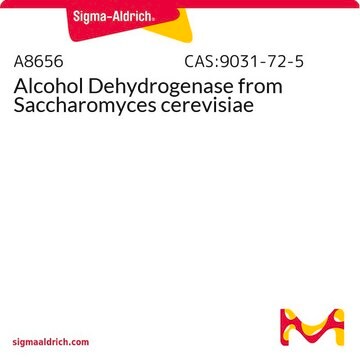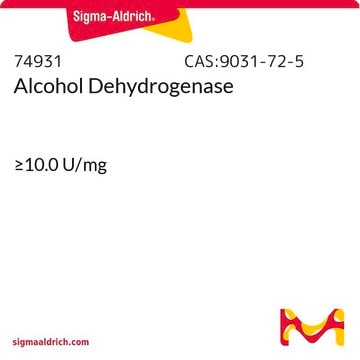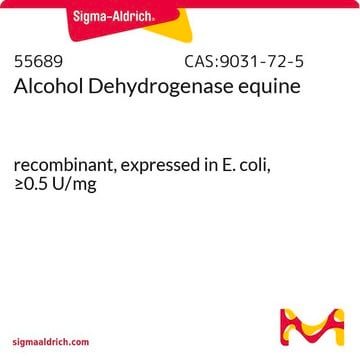Kluczowe dokumenty
A7011
Alcohol Dehydrogenase from Saccharomyces cerevisiae
≥300 units/mg protein, lyophilized powder (contains buffer salts), Mw 141-151 kDa
Synonim(y):
ADH1, Adh1p, SCAD, YDAH-1, YIM-1, ADH, Alcohol Dehydrogenase from yeast, Alcohol:NAD+ oxidoreductase
Wybierz wielkość
236,00 zł
Wybierz wielkość
About This Item
236,00 zł
Polecane produkty
pochodzenie biologiczne
Saccharomyces cerevisiae
Formularz
lyophilized powder (contains buffer salts)
aktywność właściwa
≥300 units/mg protein
masa cząsteczkowa
Mw 141-151 kDa
oczyszczone przez
crystallization
warunki przechowywania
(Keep container tightly closed in a dry and well-ventilated place.)
charakterystyka ekologicznej alternatywy
Waste Prevention
Design for Energy Efficiency
Learn more about the Principles of Green Chemistry.
sustainability
Greener Alternative Product
kolor
white to light yellow-brown, Light brown
optymalne pH
8.6-9.0
rozpuszczalność
H2O: soluble 1.0 mg/mL, clear to slightly hazy, colorless to faintly yellow
soluble
numer dostępu UniProt
Zastosowanie
diagnostic assay manufacturing
kategoria ekologicznej alternatywy
, Enabling
Warunki transportu
dry ice
temp. przechowywania
−20°C
Szukasz podobnych produktów? Odwiedź Przewodnik dotyczący porównywania produktów
Powiązane kategorie
Opis ogólny
Yeast alcohol dehydrogenase 1 (ADH1) belongs to the family of zinc-containing alcohol dehydrogenases. It is a homotetramer with each subunit containing one catalytic domain and coenzyme-binding domain.[1]
Zastosowanie
Ethanol concentration can be determined colorimentrically by monitoring the enzymatic reduction of NAD using alcohol dehydrogenase after preremoval of the aldehyde group.[4]
Działania biochem./fizjol.
Isoelectric point: 5.4-5.8
Optimal pH: 8.6-9.0
Substrates: Yeast ADH is most active with ethanol and its activity decreases as the size of the alcohol increases or decreases. Branched chain alcohols and secondary alcohols also have very low activity.
KM (ethanol) = 2.1 × 10-2 M
KM (methanol = 1.3 × 10-1 M
KM (isopropanol) = 1.4 × 10-1 M
Inhibitors: Compounds that react with free sulfhydryls, including N-alkylmaleimides and iodoacetamide.
Zinc chelator inhibitors, including 1,10-phenanthroline,
8-hydroxyquinoline, 2,2′-dipyridyl, and thiourea.
Substrate analogue inhibitors, including β-NAD analogs, purine and pyrimidine derivatives, chloroethanol, and fluoroethanol.
Extinction Coefficient: E1% = 14.6 (water, 280 nm)
Przestroga
Definicja jednostki
Postać fizyczna
Uwaga dotycząca przygotowania
przeciwciało
Kod klasy składowania
11 - Combustible Solids
Klasa zagrożenia wodnego (WGK)
WGK 3
Temperatura zapłonu (°F)
Not applicable
Temperatura zapłonu (°C)
Not applicable
Środki ochrony indywidualnej
Eyeshields, Gloves, type N95 (US)
Wybierz jedną z najnowszych wersji:
Certyfikaty analizy (CoA)
Nie widzisz odpowiedniej wersji?
Jeśli potrzebujesz konkretnej wersji, możesz wyszukać konkretny certyfikat według numeru partii lub serii.
Masz już ten produkt?
Dokumenty związane z niedawno zakupionymi produktami zostały zamieszczone w Bibliotece dokumentów.
Klienci oglądali również te produkty
Protokoły
To measure alcohol dehydrogenase activity, this assay uses β-nicotinamide adenine dinucleotide phosphate and a continuous spectrophotometric rate determination at 340 nm.
Active Filters
Nasz zespół naukowców ma doświadczenie we wszystkich obszarach badań, w tym w naukach przyrodniczych, materiałoznawstwie, syntezie chemicznej, chromatografii, analityce i wielu innych dziedzinach.
Skontaktuj się z zespołem ds. pomocy technicznej








